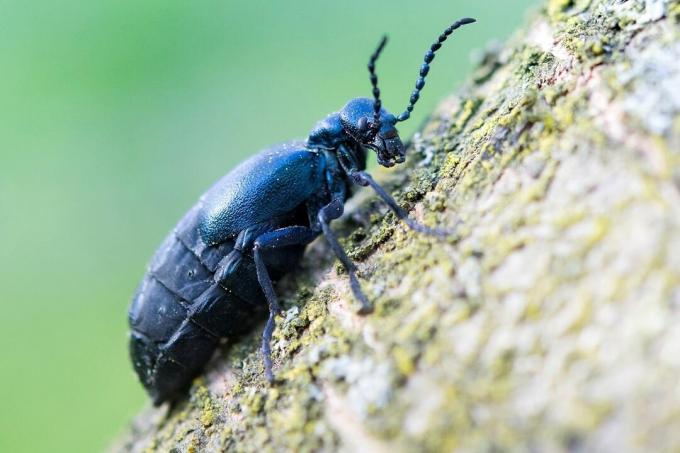
Reports of excessive spread of the oil beetle repeatedly point to its toxicity. We took a closer look at the insect. Read here how dangerous the oil beetle really is.
Identify oil bugs
Around 7000 live in Germany beetle species, including about 15 oil bugs. The black-blue beetle (Meloe proscarabaeus) and the violet oil beetle (Meloe violaceus) are the most common. The beetles feel particularly comfortable in warm, sandy and open places. From April to early summer, they can therefore be found in sunny meadows in particular. You can recognize the oil beetle by these characteristics:
- up to 3.5 centimeters body length
- elongated but stocky body shape
- black-blue or blue to violet blue shiny chitin armor
- Head and pronotum punctured
- greatly shortened elytra
Source: Juandev, NPR Kněžičky, majka obecná (003), Edited from Plantopedia, CC BY-SA 3.0
A notice: The beetle is also often referred to as the "Mayworm". On the one hand, it owes this trivial name to the fact that it mainly appears in the merry month of May, and on the other hand to the worm-like habit of the female.
Oil bugs are poisonous
No matter what species or gender – all oil beetles have one thing in common: if there is danger, they secrete a yellow weir secretion, which contains the toxin cantharidin, which is also dangerous for us humans contains. The animals expel this through their pores and knee joints when they feel threatened.
However, the oil beetle is not really dangerous. He is not aggressive and only uses the poison for defense. The Nature Conservation Union (NABU) also points this outthat so far no dangerous poisonings in pets or humans caused by it are known are.
A notice: The toxin was long considered an aphrodisiac. Often with fatal consequences.
our recommendation
However, we strongly advise against touching the poisonous beetle with your hands (or any other part of your body). If physical contact does occur, reddening of the skin and blisters may result. In such cases, the poison control center advises washing your hands thoroughly with soap and cooling the affected areas. Only those who swallow whole beetles should consult a doctor.
If you want, you can watch the animals from a safe distance. In principle, you should avoid the oil beetle – like most people insect species anyway - just let your contribution to the ecological balance be made in peace.
Source: No machine-readable author provided. zonky assumed (based on copyright claims)., Meloe violaceus oelkaefer 20050410, Edited from Plantopedia, CC0 1.0
By the way: According to estimates, only about every thousandth oil beetle larva actually becomes a beetle. If you also know about the decline in their natural habitats, it is therefore not surprising that the insects are actually quite rare - contrary to reports. Oil bugs are almost inevitable in this country the Red List of Threatened Species again. You will be given special protection.
A notice: Did you know that the black-blue oil beetle was voted insect of the year 2020? This annual award aims to draw attention to useful but endangered small wildlife.
